Senna, Fan Xie Ye 番泻叶Fan Xie Ye (TCM)Svarna-pattri, Markandi (Ayurveda) Sanna (Unani) |

|
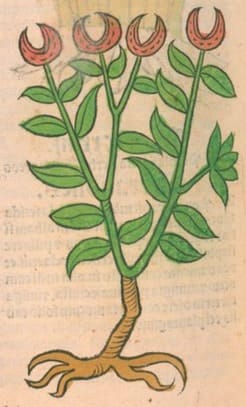 Ortus Sanitatis, Meydenbach, 1491
Ortus Sanitatis, Meydenbach, 1491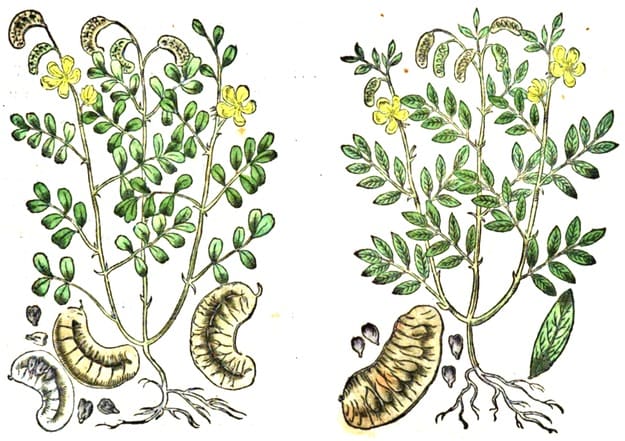 Left: Indian Senna (C. angustifolia); Right: Alexandrian Senna (C. acutifolia)
Left: Indian Senna (C. angustifolia); Right: Alexandrian Senna (C. acutifolia)Kreutterbuch, Matthiolus, 1586
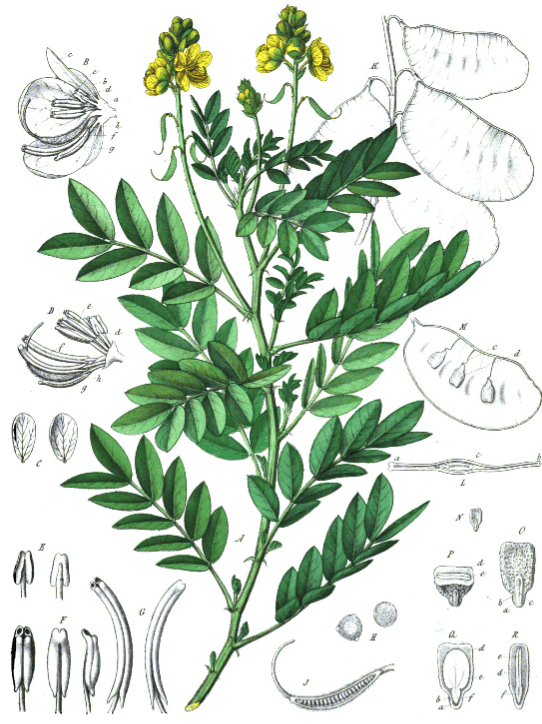 Cassia acutifolia
Cassia acutifoliaAtlas der officinellen pflanzen (2), Felix, 1899 |
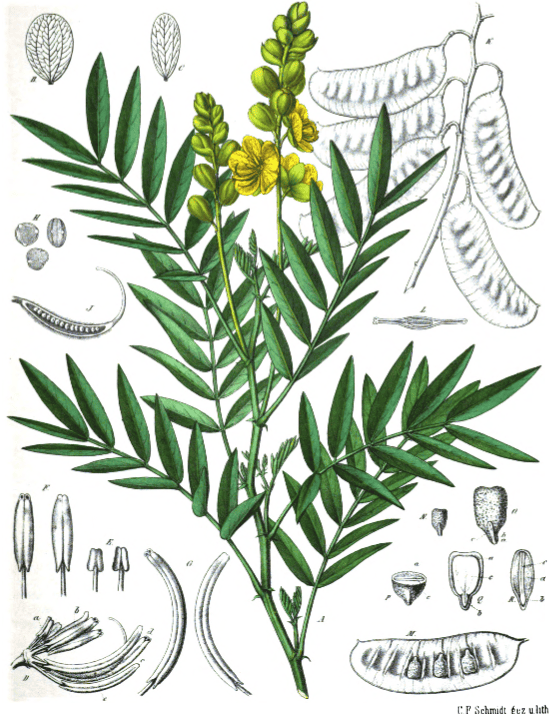 Cassia angustifolia
Cassia angustifoliaAtlas der officinellen pflanzen (2), Felix, 1899 |
 Members CLICK HERE for the PRO VERSION
Members CLICK HERE for the PRO VERSION
Botanical name:Cassia spp. 1. Alexandrian Senna: C. acutifolia 2. Tinnevelly Senna: Indian Senna: C. angustifolia (syn. Cassia senna) Parts used:Leaf; Pods Temperature & Taste:Cold, dry. Bitter, Sweet Classifications:2A APERIENT. 2F. PURIFYING. 2G. CLEANSING 3Q. ANTHELMINTIC 4f. SPLENETIC |
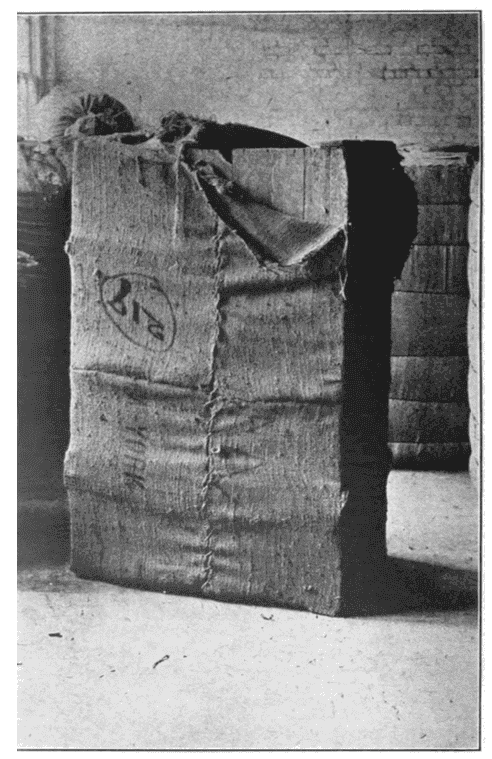 Alexandrian Senna, Squibb’s Atlas
Alexandrian Senna, Squibb’s Atlasof the Official Drugs, Mansfield, 1919 |
Uses:
1. Clears Heat, Opens Obstructions, Promotes Stool:
-acute constipation from excess heat in the Intestines.
-abdominal fullness, especially in habitual constipation.
-aids detoxification in conditions such as skin disorders.
-Its ‘downward’ effect can be used to promote menstruation, and guides heat down from the upper body as Rhubarb does.
-Pancreatitis, Cholecystitis, as well as heat-type gastrointestinal bleeding etc.
-taken in small doses in apoplectic coma, facilitates recovery.
2. Purges Melancholy:
-Senna was much used by Greek, European and Persian physicians to purge the Melancholy humor.
-chronic skin diseases, Fibroid tumors, mental illness
-it clears the Mind when affected by excess Humors
3. Clears Damp, Promotes Urine:
-Edema, Ascites
-obstructed Urine
Dose:
Powder: 1–3 grams
Infusion: 2–4 grams
Correctives:
… available in PRO version

Main Combinations:
1. Constipation:
i. Senna with … available in PRO version
ii. Senna with … available in PRO version
iii. Senna with … available in PRO version
2. To purges Phlegm and Melancholy, Senna with … available in PRO version
3. Wind, Colic, obstructions of the Bowels, Womb, Kidneys, Spleen and Bladder, Senna with … available in PRO version
4. To Purge Melancholy, Senna with … available in PRO version
5. To purge Phlegm and Melancholy from the Head, for Headache, Senna with … available in PRO version
6. Constipation with Indigestion, Senna with … available in PRO version
7. To purge Phlegm and Bile, in Jaundice, Scrofula etc., Senna with … available in PRO version
8. Melancholy, Madness and for chronic Skin diseases, Senna with … available in PRO version
9. Apoplexy and Paralysis, Senna with … available in PRO version
10. Elixir of Health, Senna with … available in PRO version
11. To benefit Memory, Senna with … available in PRO version
12. Purgative for Worms, Senna leaf, … available in PRO version
13. To make the hair black, Senna with … available in PRO version
Major Formulas:
Infusion of Senna and Flower with Spices (Mesue)
Decoction of Senna
Syrup of Senna Comp.
Powder of Senna (Montagna)
Powder of Senna with Flowers (Mesue)
Powder to Purge Melancholy (Mesue)
Powder for Melancholy (Mesue)
Powder of Three Solutives (Augustine Pharmacopoeia)
Special Powder for Memory (Wirtzung)
Electuary of Senna (Disenna) (Nicholas)
Electuary for Scabies and Pruritis (Rhasis)
The Queen of Colen’s Electuary
Imperial Pills
Pills of Fumitory and Senna (Unani)
Cautions:
1. Not used during pregnancy, or by nursing mothers, or in marked weakness.
2. Not used for chronic Constipation, or on an extended basis.
3. Not given in inflammations of the digestive system, Piles or Menorrhagia, or prolapse of the rectum or uterus.
4. Overdose causes nausea, vomiting and abdominal pain. As with all these sorts of medicine, prolonged use may cause dependence.
5. Chronic use or large doses may cause Hepato-toxicity, and may lead to Hepatic Vein Thrombosis.
Toxicity
Acute liver failure with renal impairment related to the abuse of senna anthraquinone glycosides.
Main Preparations used:
Compound Powder (several), Syrup, Laxative Raisins, Extracts, Tincture
|
‘Senna was first used as a purgative medicine by the early Arabian physicians, who introduced it into Europe. The Sana-maki of native works on Materia Medica is Arabian Senna imported into India. The same species has latterly been cultivated in this country, especially about Tinnevelly, from which place large quantities of the leaf are exported to Europe. In the Bombay market Indian grown Senna is now always obtainable; much also passes through the port on its way to Europe, being brought up from Tuticorin by the steamers which ply round the coast. Bombay is, moreover, the chief port for the importation of Arabian Senna, which is shipped from Mokha, Aden, and other Red Sea ports, and, re-exported, is known in Europe as Bombay Senna. Sana-maki is described in native works on Materia Medics as a purgative of phlegm and adust bile, clearing the brain, and acting as an attenuant of the system generally; it is considered especially useful in those diseases which are caused by an accumulation of corrupt humours, such as gout, rheumatism, &c. It is also thought to clear the skin of pimples, to expel worms from the intestines, and to remove any tendency to piles. Senna is prescribed in decoction and as a confection. A plaster made by mixing the powdered leaves with vinegar is recommended in skin affections; and combined with Henna is used to dye the hair black. In the Concan the seeds with those of Cassia Fistula are pounded with curds and applied to cure ringworm; the seeds of Cassia obovata are used in a similar manner. Senna appears to have been introduced into Europe by the Arabians about the |
ninth century. In France, in 1542, a pound of Senna was valued at 15 sols, the same price as-pepper or ginger. The Arabian Senna, called Sana Hajazi or Jabali, is the produce of the uncultivated plant; it is collected by the Arabs in a careless manner, and is much mixed with pods, flowers, and portions of the stem; the natives consider .the pods to be quite as efficacious as the leaves. The therapeutic action of Senna pods, as differing widely from that of Senna leaves, is the subject of an interesting note by Dr. A. W. Macfarlane. (Lancet, July 27th, 1889.) He finds that an infusion of the pods presents the advantage of being almost free from taste and devoid of the characteristic odour and flavour of the leaves. It appears to increase activity in the muscular movements of the whole gastro-intestinal canal, acting quite as much on the colon and rectum as on the small intestine. It is slower in its action than an infusion of the leaves, but equally certain; an ordinary dose producing one motion seldom more, of soft consistence, in from eight to ten hours, without exciting congestion of the pelvic vessels, in creasing haemorrhagic or menstrual discharges, or causing griping or flatulence. When administered regularly for several nights, it promotes the natural evacuation of the bowels, so that the quantity taken has to be decreased and eventually stopped. It has been found useful in cases of haemorrhoids and in constipation of children as well as the aged.’ (Pharmacographia Indica, Dymock, 1893) |
